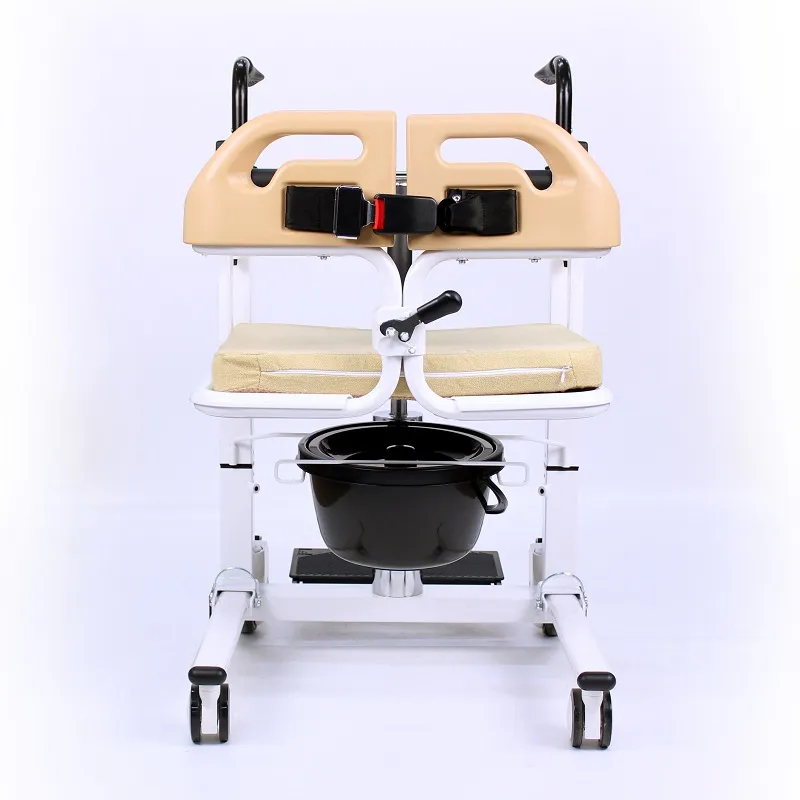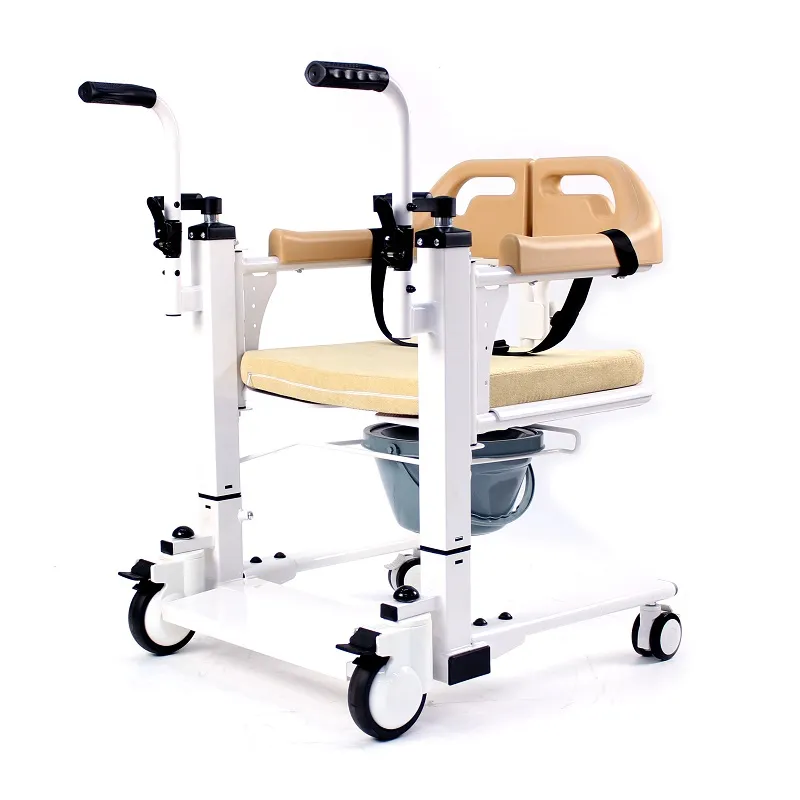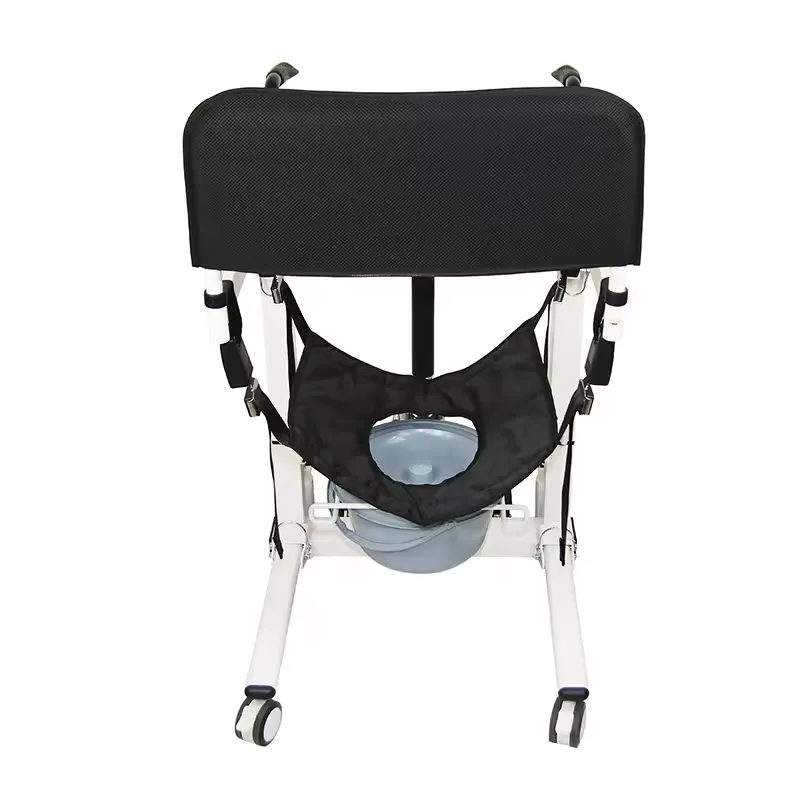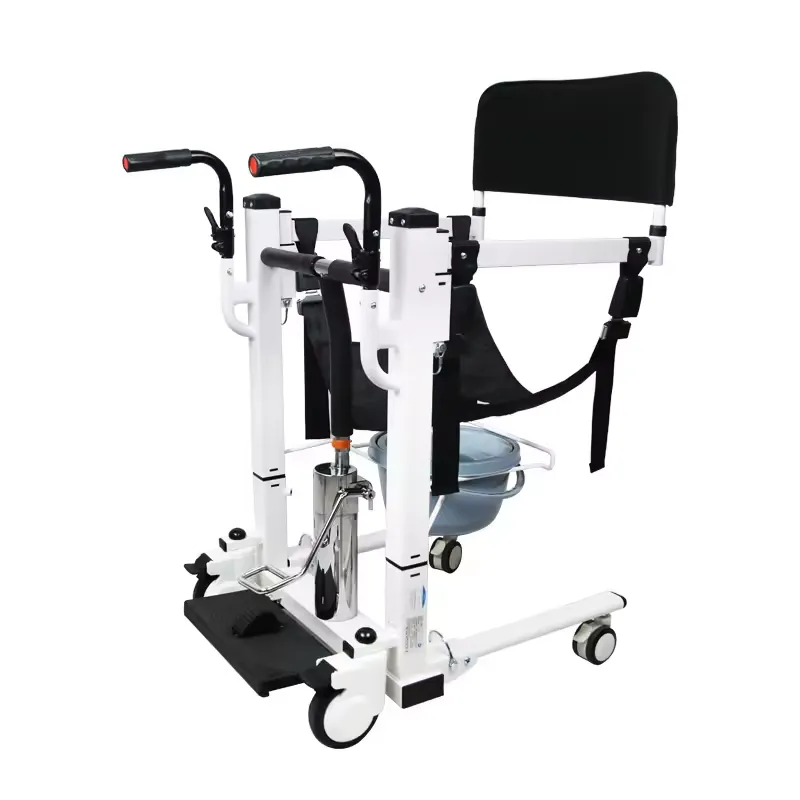In modern medical institutions, safe patient transfer is a crucial component of nursing care. Whether during admission, examination, surgery, rehabilitation, or discharge, patient movement requires efficient, safe, and user-friendly equipment support.
Among numerous medical assistive devices, the lift transfer chair has become an indispensable intelligent transfer tool in hospitals.
So, which departments are suitable for using a Patient Lift Transfer Chair? What are the specific needs of different departments when using this type of equipment? This article will provide a systematic analysis from a multidisciplinary perspective.

What is a Lift Transfer Chair?
A lift transfer chair is a medical assistive device specifically designed for the safe movement of patients. It possesses multiple functions, including lifting, transfer, folding, braking, and armrest support. Unlike traditional manual wheelchairs or stretchers, it can achieve electric or hydraulic lifting, helping medical staff easily transfer patients from bed to examination table, from ward to operating room, and in various scenarios, significantly reducing the workload of nursing staff and improving transfer efficiency and patient comfort.
Key features of a lift transfer chair:
• Height adjustment: Adjustable to different bed heights and equipment heights, reducing patient movement.
• Braking and safety design: Foot brake system, anti-tipping structure, and lockable casters.
• Foldable and portable: Saves space and is easy to store.
• Ergonomic seat design: Improves patient comfort and prevents secondary injuries.
• Versatile application: Suitable for use in wards, operating rooms, ICUs, emergency rooms, etc.
Why are hospitals increasingly needing lift transfer chairs?
As medical institutions increasingly emphasize a "patient-centered" service philosophy, patient experience has become a crucial indicator of hospital management. Traditional trolleys and stretchers have many drawbacks, such as:
• Difficulty in changing posture during transport;
• Requires multiple assistants for transport;
• Causes back injuries to nursing staff;
• Increased patient discomfort or fear;
• Risk of falling during transfer.
The transfer lift chair, through intelligent design, enables smooth and safe single-person patient transport. Its high adaptability and safety features have led to an increasing number of departments equipping themselves with this type of equipment.

Which departments are suitable for using lift transfer chairs?
Different departments have different patient conditions and different transport needs. Below, we will explain in detail by department.
1. Emergency Department: Core equipment for rapid rescue and safe transport
The emergency department is one of the departments in a hospital that most needs lift transfer chairs. Emergency patients are often unconscious, bleeding from injuries, and have difficulty moving; the efficiency of transport directly affects the success or failure of treatment.
The advantages of transfer lift chairs in the emergency department include:
• Rapid response: The electric lifting structure can adjust the height within seconds, facilitating the transfer of patients from the ambulance to the examination bed.
• One-person operation: Even with limited staff, medical staff can independently complete the transport.
• Safety protection: Equipped with safety belts and locking wheels to prevent sudden slippage or falls.
• Easy disinfection: Made of antibacterial materials, meeting the high-frequency use requirements of the emergency room.
Therefore, the emergency department is almost always the first department in all hospitals to introduce lift transfer chairs.
2. Radiology Department: The Ideal Choice for Precise Positioning and High-Frequency Transfer
Radiology patients frequently need to change positions or move to different equipment platforms, such as CT scanners, MRI machines, and X-ray machines, during examinations. Due to the varying heights of these devices, traditional transfer methods often lead to difficulties and even injuries.
The value of a lift transfer chair is particularly evident in radiology:
• It can precisely adjust its height to match the examination table, reducing the number of moving steps;
• It ensures smooth transfers, maintaining consistent positioning before and after imaging examinations;
• It saves medical staff manpower and improves examination efficiency;
• It reduces patient discomfort and enhances the overall experience.
Especially for the elderly, postoperative patients, and critically ill patients, the transfer lift chair significantly improves the safety and convenience of radiological examinations.
3. Internal Medicine Ward: A Daily Transfer Assistant for Chronic Disease Patients
Patients in internal medicine wards often suffer from chronic diseases, cardiovascular diseases, diabetic complications, etc., and have limited mobility. For these patients, even short-distance daily transfers (such as from bed to toilet, from ward to rehabilitation area) can be challenging.
The value of a lift transfer chair in internal medicine wards lies in:
• Assisting patients in getting in and out of bed, reducing the physical exertion of caregivers;
• Alleviating patient pain and fear;
• Facilitating transfer to bathing or hygiene areas;
• Enabling early rehabilitation activities and promoting blood circulation.
Therefore, in internal medicine wards, a lift transfer chair is not only a mobility tool but also a nursing aid.
4. Surgical and Operating Room: Seamless Pre- and Post-operative Transfers
Surgical patients often need to be transferred between different areas before and after surgery, such as from the ward to the operating room, or from the operating table to the recovery room. At this time, patients are physically weak and often have wounds or tubes. Improper transfer can easily cause increased pain or wound traction.
The advantages of using a transfer lift chair in surgical systems include:
• Height adjustable, allowing for a smooth transition to the operating table or trolley height;
• Soft seat support, reducing wound pressure;
• Multi-angle tilt function, facilitating observation of the patient's condition;
• Easy to disinfect and clean, meeting aseptic management requirements.
In the surgical system, the transfer lift chair is a key piece of equipment for safe and efficient patient transfer.

5. Rehabilitation and Physiotherapy Departments: Ideal Assistive Device for Rehabilitation Training
Rehabilitation patients are often in the postoperative recovery period or have motor dysfunction, requiring frequent transfer training. Traditional wheelchairs, with their fixed height and support angle, are difficult to accommodate different rehabilitation movements. The lift transfer chair, with its adjustable design, perfectly solves this problem.
Specific advantages include:
• Flexible and adjustable height, compatible with rehabilitation training equipment;
• Tilting design, suitable for positional change training;
• Stable support structure, reducing the risk of falls;
• Easy for single-person operation by caregivers.
The lift transfer chair is not only a transport device but also a rehabilitation assistive tool, creating conditions for patients to regain independent mobility.
6. ICU (Intensive Care Unit): Ensuring Safe Transfer of Critically Ill Patients
ICU patients often rely on monitors, IV stands, ventilators, and other equipment, requiring stable and precise transfer. Any vibration or change in posture can cause fluctuations in vital signs.
The core functions of a lift transfer chair in the ICU include:
• A smooth lifting system to prevent swaying;
• Multi-point support and safety belt design to ensure tubing safety;
• Emergency braking and anti-tipping functions;
• Support for integration with other medical equipment.
Therefore, in the ICU environment, the lift transfer chair is not only a convenient piece of equipment but also a life support guarantee.
7. Geriatrics and Nursing Homes: High-Frequency Use Scenarios for Long-Term Care
In geriatric wards or nursing facilities, patients generally have limited mobility. Frequent movement needs (such as for meals, washing, and going out for examinations) place a heavy workload on caregivers. The transfer lift chair plays a crucial role in this scenario.
Application benefits include:
• Transfer operations can be completed by a single person;
• Reduced care risks and labor intensity;
• Increased mobility opportunities for the elderly, promoting rehabilitation;
• Electric lifting for greater user comfort and improved care experience.
This is also one of the fastest-growing sectors for lift transfer chair procurement in elderly care institutions.

Common Needs of Lift Transfer Chairs in Departmental Use
While different departments may have different uses, the common needs for lift transfer chairs can be summarized as follows:
• Safety: Anti-slip, anti-tipping, and safety locking system;
• Comfort: Ergonomic design with soft cushions;
• Ease of Operation: Easy height adjustment and one-button braking;
• Easy Cleaning: Antibacterial and waterproof materials for easy daily disinfection;
• Multifunctional Compatibility: Compatible with beds, trolleys, CT scanners, etc.
When purchasing lift transfer chairs, hospitals should consider the workflow of different departments and select models with high reliability and adaptability.
What is the difference between a transfer lift chair and a regular wheelchair?
Regular wheelchairs are mainly used for patient self-mobility, while transfer lift chairs focus more on nursing assistance and safe transport, featuring height adjustment, tilting, and anti-slip functions, making them suitable for high-frequency use in medical institutions.
Do all departments need a uniform model of lift transfer chair?
Not necessarily. Different departments have different needs. For example, the ICU requires a focus on stability, radiology requires high compatibility, and the emergency department requires attention to movement speed and safety harness configuration.
Can a lift transfer chair replace a stretcher?
In some scenarios, yes. For example, short-distance intra-hospital transport, ward transfers, and connections between examination rooms. However, for emergency resuscitation scenarios, a stretcher remains essential.
Is professional training required to use a lift transfer chair?
Most modern transfer lift chairs use intelligent control panels, and medical staff can master their use after simple training.
Why is Dayang Medical a reliable factory in China?
Dayang Medical is a reliable factory and manufacturer in China because we combine certified production, advanced R&D, and competitive sales strategies. Our products cover a wide range—wheelchairs, hospital beds, walking aids, and more—all designed with high quality standards. We support wholesale supply, bulk purchasing, and customized branding for global partners. Clients who buy from our company benefit from cheap factory prices, discount promotions, and transparent quotes.










